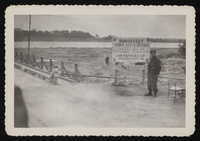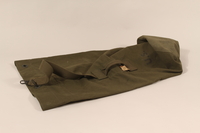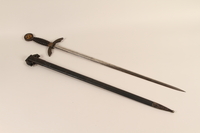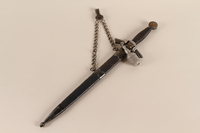Overview
- Brief Narrative
- Morton Cohen was summoned by a colonel after hostilities ended to accompany him to a conference and serve as a translator. It turned out that his translating skills were not required and he waited outside of the inn which served as a conference site. While waiting, he was surprised by a Russian soldier approaching on horseback. The soldier was Russian, and upon learning that Cohen was American, handed him his saber as a token of friendship. Cohen was the first American the Russian soldier had ever met. In return, Cohen gave the man his watch.
- Credit Line
- United States Holocaust Memorial Museum Collection, Gift of Morton Cohen
Physical Details
- Classification
-
Weapons
- Category
-
Daggers and swords (edged weapons)
- Object Type
-
Sabers (lcsh)
- Physical Description
- Large with black handle.
Rights & Restrictions
- Conditions on Access
- No restrictions on access
- Conditions on Use
- No restrictions on use
Administrative Notes
- Legal Status
- Permanent Collection
- Provenance
- The saber was donated to the United States Holocaust Memorial Museum in 1990 by Morton Cohen.
- Record last modified:
- 2022-07-28 18:21:27
- This page:
- https://collections.ushmm.org/search/catalog/irn3665
Download & Licensing
In-Person Research
- By Appointment
- Request 21 Days in Advance of Visit
- Plan a Research Visit
- Request to See This Object
Contact Us
Also in Morton Cohen collection

Morton N. Cohen collection
Document
The Morton N. Cohen collection includes personal photographs taken by Morton N. Cohen while he served in the United States 95th Infantry Division, as well as a typed manuscript of the history of the 95th Infantry Division. The photographs reveal scenes from the Division’s travel throughout France, Germany, and Holland. Of particular note are photographs of the arrest of Franz Von Papen, former Vice-Chancellor of Germany under Adolf Hitler from 1933 to 1934, photographs of a Soviet prisoner of war (POW) concentration camp located in Warstein, Germany, and photographs of soldiers on ships returning to the United States. The printed materials in the Morton N. Cohen collection include the “History of the 95th Signal Company,” written by Wilson C Beneditz, Oscar Hackbarth, Ray Carr, and Younger Tomas. This typed document chronicles the activities of the Signal Company of the 95th Infantry Division in Europe. The booklet, Bravest of the Brave: The Story of the 95th Infantry Division, traces the European route of the 95th Infantry Division with US Signal Corps photographs. It was printed by Desfosses-Neogravure in Paris, France. The 9V Victory magazine provides a photographic record of the combat achievements of the 95th Infantry Division. It was published by the Public Relations Office of the 95th Infantry Division and features photographs by the US Army Signal Corps, Associated Press, French Press Agency, and the 95th Infantry Division. The magazine’s inside cover contains an inscription written by Morton Cohen. The photographs in the collection were taken by Morton N. Cohen while serving with the 95th Infantry Division. The photographs include the arrest of Franz Von Papen, who was discovered at his son-in-law’s hunting lodge in the Ruhr, a concentration camp for Soviet POWs in Warstein, Germany, and towns and city scenes from the 95th Infantry Division’s advance through Europe. The photographs capture the everyday experiences of United States soldiers in Europe, significant war damage in towns and cities, the wreckage of German aircraft, captured German soldiers, European civilians, and the return of United States soldiers on ship. The photographs are arranged by location, when identified, and are dated between 1944 and 1945. Several of the photographs include annotations written by Morton N. Cohen.

Duffel bag used by a US Army soldier during the war in Europe
Object
Duffel bag shipped by Morton N. Cohen in October 1945 to the United States at the end of his tour of duty in Europe. Cohen served in the 95th Infantry Division in Europe and saw combat at Metz, Maginot and Siegfried lines, Ruhr. He was a liberator of the Soviet POW camp Warstein in the Ruhr, and participated in the arrest of Hitler's Vice-Chancellor, Franz von Papen.
![Schutzpolizei [Security police] helmet taken from a captured German by a US soldier Schutzpolizei [Security police] helmet taken from a captured German by a US soldier](https://www.ushmm.org/media/emu/get?irn=3599&mm_irn=23400&file=secondary)
Schutzpolizei [Security police] helmet taken from a captured German by a US soldier
Object
Schutzpolizei [Security police] helmet taken by Morton Cohen, a US soldier, from a captured German soldier.

Helmet taken from a captured German by a US soldier
Object
Helmet taken by Morton Cohen, a US soldier, from a captured German soldier.

Sword
Object
Morton Cohen took this sword from a weapons room attached to an officers' barracks in a German town.

Nazi dagger and sheath
Object
Morton Cohen took this dagger from a weapons room attached to an officers' barracks in a German town.
Nazi banner with swastika removed from building in Germany
Object
Banner was taken down from a municipal building towards the end of the war, in a German town by Morton Cohen, an interpreter for the United States Army, stationed in Germany.
Nazi banner with swastika found in Germany
Object
Banner was taken down from a municipal building in Germany, towards the end of WWII, by Morton Cohen, an interpreter for the United States Army who was stationed in Germany.



